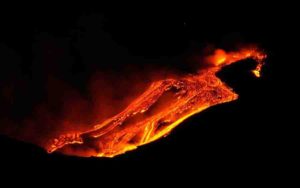
Scientists have developed an automated early warning system for volcanic eruptions, according to a new study. The new system helped government officials warn the public of impending eruptions in Italy and could potentially do the same around the globe, according to the study’s authors.
New research in the Journal of Geophysical Research: Solid Earth, a journal of the American Geophysical Union, details the new system that monitors volcanic noises and automatically alerts officials if an eruption is imminent. The study’s authors tested this system over a period of eight years on Mount Etna, a volcano on the island of Sicily. Using the new system, the Italian government activated an emergency plan about one hour prior to an eruption for the first time in late 2015.
A majority of the approximately 1,500 active volcanoes around the world are not monitored in real time. Many volcanoes are monitored with methods based on seismic waves, which are vibrations of the Earth’s layers that can be triggered by eruptions. But seismic waves are often not great at telling volcanic explosions apart from other processes, like internal magma movements, earthquakes, or storms, the study’s authors said. Most of the methods require input from volcano experts and alerts are sent only after volcanoes begin erupting.
Aircraft pilots, for example, should know about volcanic eruptions as early as possible, said Maurizio Ripepe, a geophysicist at the University of Florence in Florence, Italy, and lead author of the new study. On several occasions in the past, aircraft encounters with volcanic ash clouds have led to engine failure.
“Tens of seconds sometimes can save lives and reduce damage, like in the case of an earthquake” Ripepe said. “The need is to have something automatic that can be used to speed up the procedure to reduce risk.”
Volcanic noises can enable early warnings to be issued quickly and dependably, according to Ripepe. Volcanoes generate low-frequency sounds inaudible to human ears during their eruption processes, and these infrasonic waves can travel over thousands of kilometers and are more closely related to volcanic eruptions than seismic waves, he said.
In the new study, researchers listened to sounds produced by Mount Etna for years with arrays of infrasonic sensors placed 6 kilometers (3.7 miles) from the volcano.
They found the infrasound sensors can reliably identify eruption signals. From 2008 to 2016, the sensors detected 57 of 59 eruptions and sent alerts to the researchers about an hour before each eruption.
“When we got this percentage of success, [the Department of Italian Civil Protection] decided to use it as an operational system,” Ripepe said. “Now we send SMS messages and emails to the authorities that are in charge to start an emergency plan in case of volcanic eruption.”
On Dec. 4, 2015, a warning was automatically issued to the Italian government almost two hours before an eruption, which allowed the government to activate emergency plans about one hour in advance of a volcanic eruption for the first time, Ripepe said. For the last four years, the automated system has remained operational in monitoring Etna and has issued warnings without error.
To extend the benefits of automated warnings to the rest of the world, researchers must study infrasound from other types of volcanoes. Early eruption phases in Etna, which allow for early warnings, may be shorter or completely absent in volcanoes with different dynamics, according to the authors.
Another hurdle for global monitoring is the area of coverage required to monitor all active volcanoes around the globe, but infrasound could offer a solution, Ripepe said.
The idea for a global warning system would be to use infrasonic arrays to monitor several volcanoes at once over long distances, Ripepe said. As a first step, the researchers studied an array set up hundreds of kilometers away from Etna. They found these measurements to be favorable and are now studying arrays up to 1,000 kilometers (621.3 miles) away from the volcano.
“This opens a new way to do monitoring of volcanoes at the global scale,” Ripepe said.
Reference:
M. Ripepe et al. Infrasonic Early Warning System for Explosive Eruptions, Journal of Geophysical Research: Solid Earth (2018). DOI: 10.1029/2018JB015561
Note: The above post is reprinted from materials provided by American Geophysical Union.
This story is republished courtesy of AGU Blogs (http://blogs.agu.org), a community of Earth and space science blogs, hosted by the American Geophysical Union.









